.
29.01.2013
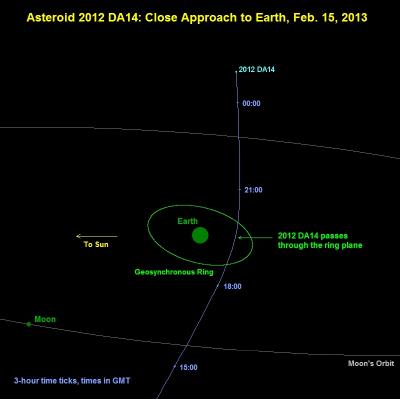
Discovered by the LaSagra observatory in southern Spain, the small asteroid 2012 DA14 will pass within about 3.5 Earth radii of the Earth's surface on February 15, 2013. Although its size is not well determined, this near-Earth asteroid is thought to be about 45 meters in diameter. Asteroid 2012 DA14 will pass inside the geosynchronous satellite ring, located about 35,800 km above the equator. Its orbit about the sun can bring it no closer to the Earth's surface than 3.2 Earth radii on February 15, 2013. On this date, the asteroid will travel rapidly from the southern evening sky into the northern morning sky with its closest Earth approach occurring about 19:26 UTC when it will achieve a magnitude of less than seven, which is somewhat fainter than naked eye visibility. About 4 minutes after its Earth close approach, there is a good chance it will pass into the Earth's shadow for about 18 minutes or so before reappearing from the eclipse. When traveling rapidly into the northern morning sky, 2012 DA14 will quickly fade in brightness.
-
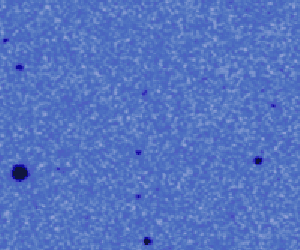
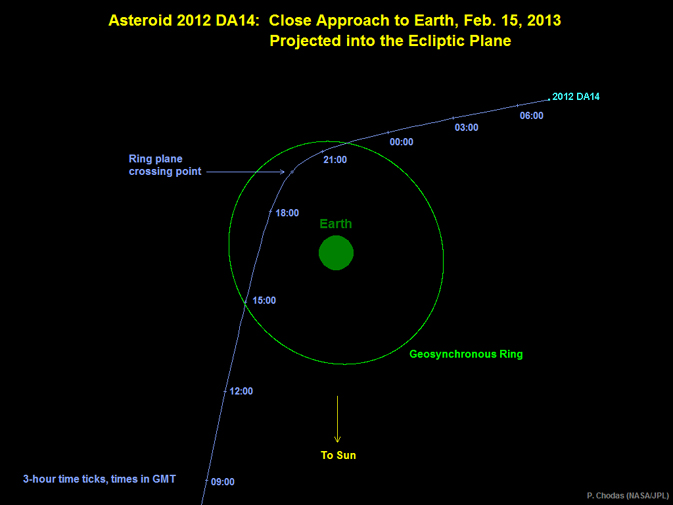
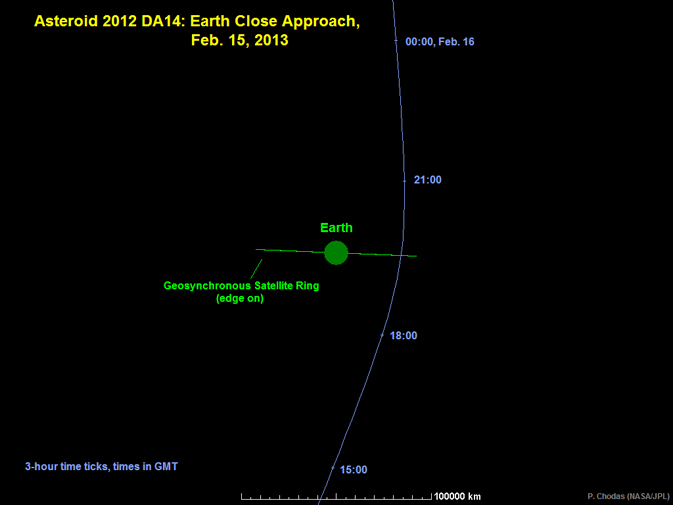
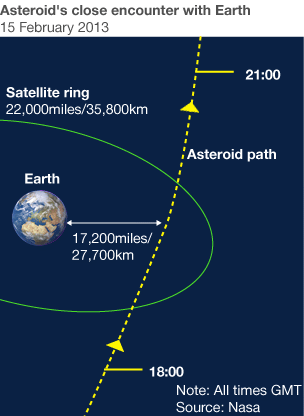
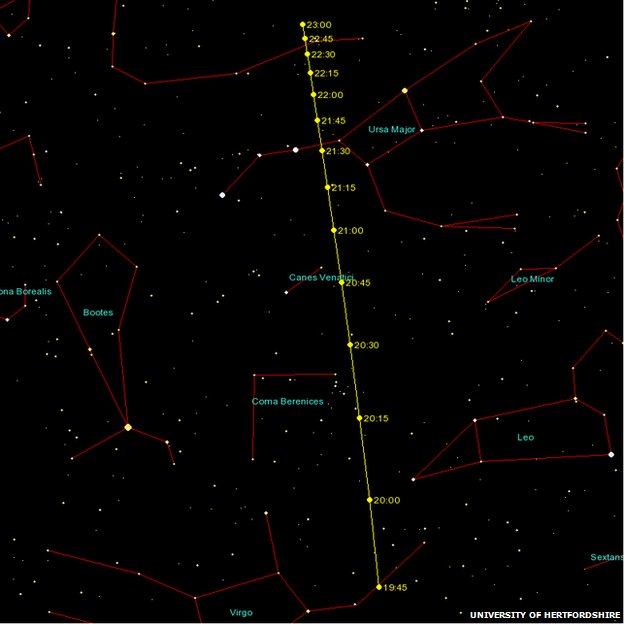
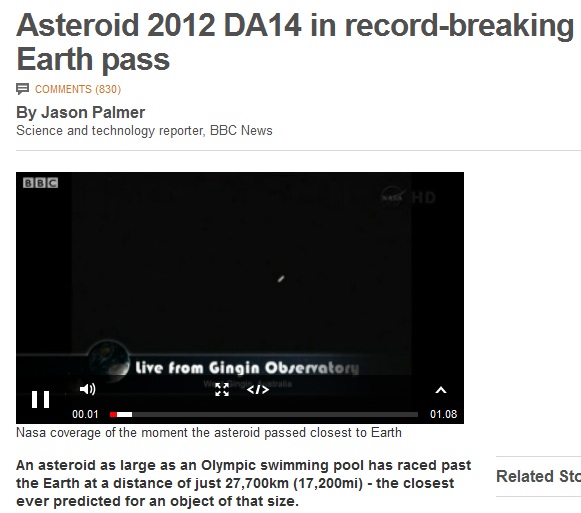
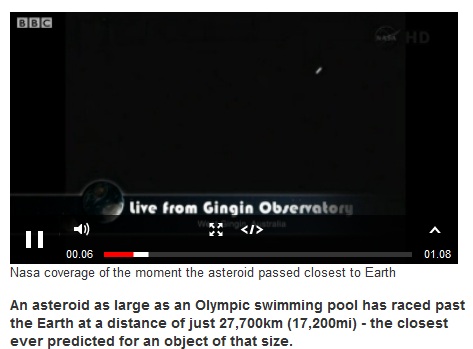
Like trailers for the coming attraction, new images show asteroid 2012 DA14 on its way to a record-close approach to Earth on Feb. 15. One image, taken by amateur astronomer Dave Herald of Murrumbateman, Australia, on Feb. 13, shows the asteroid as a tiny white dot in the field of view. Another set of animated images, obtained by the Faulkes Telescope South in Siding Springs, Australia, on Feb. 14, and animated by the Remanzacco Observatory in Italy, shows the asteroid as a bright spot moving across the night sky.
These are some of many images that may be taken of the asteroid during its close - but safe - encounter with Earth. It will be observed by numerous optical observatories worldwide in an attempt to determine its rough shape, spin rate and composition. NASA scientists will use NASA's Goldstone Solar System Radar, located in California's Mojave Desert, to take radar images of the asteroid to determine its precise size and shape on Feb. 16, 18, 19 and 20. The NASA Near Earth Object Observation (NEOO) Program will continue to track the asteroid and predict its future orbit.
Asteroid 2012 DA14 is about 150 feet (45 meters) in diameter. It is expected to fly about 17,200 miles (27,000 kilometers) above Earth's surface at the time of closest approach, which is about 11:25 a.m. PST (2:25 p.m. EST) on Feb. 15. This distance is well away from Earth and the swarm of low Earth-orbiting satellites, including the International Space Station, but it is inside the belt of satellites in geostationary orbit (about 22,200 miles, or 35,800 kilometers, above Earth's surface.) The flyby of 2012 DA14 is the closest-ever predicted approach to Earth for an object this large.
The NASA Near Earth Object Observation (NEOO) Program detects and tracks asteroids and comets passing close to Earth using ground- and space-based telescopes. The network of projects supported by this program, commonly called "Spaceguard," discovers these objects, characterizes a subset of them and plots their orbits to determine if any could be potentially hazardous to our planet.
The Near-Earth Object Program Office at JPL manages the technical and scientific activities for NASA's Near-Earth Object Observation Program of the Science Mission Directorate in Washington. JPL is a division of the California Institute of Technology in Pasadena. The NEOO Program Office performs more precise orbit determination on the objects, and predicts whether any will become an impact hazard to the Earth, or any other planet in the solar system.
.
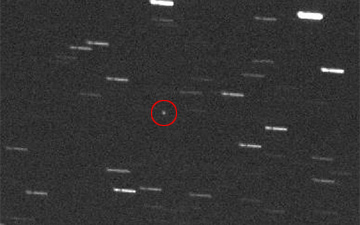
.
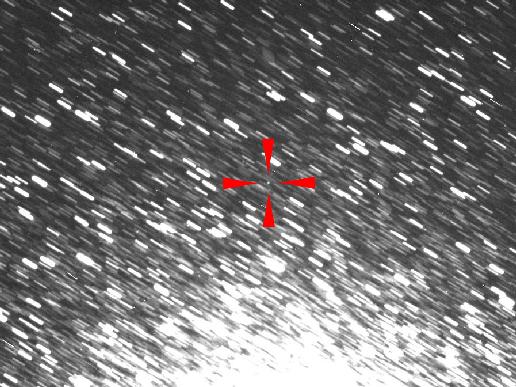
Asteroid 2012 DA14 in View
This image from D. Herald of Murrumbateman, Australia, shows the asteroid 2012 DA14 as a tiny speck in the center of the field of view. It was taken just past midnight on Feb. 13, 2013 in Australia (the morning of Feb. 12 in the U.S.), as it headed towards its closest approach to Earth on Feb. 15. The image is an overlay of 12 one-minute exposures. The asteroid is the small dot at the center, indicated by the red arrows. The white streaks are images of stars, trailed because the telescope was tracking the motion of the asteroid. At the time the image was taken, the asteroid was passing nearly in front of the globular cluster 47 Tucanae, located 17,000 light years away. The asteroid itself was only 770,000 miles (1.2 million kilometers) away, and closing in fast for its dramatic close approach on Feb. 15. At its closest, 2012 DA14 is expected to fly safely by the Earth at about 17,200 miles (27,700 kilometers) above the surface..

This animated set of three images depicts asteroid 2012 DA14 as it was seen on Feb. 14, 2013, at a distance of 465,000 miles (748,000 kilometers). Image credit: LCOGT/Faulkes
.
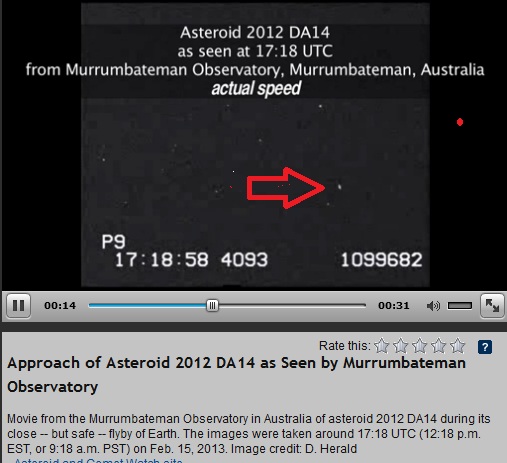
Quelle: NASA
.
Update: 16.02.2013
.
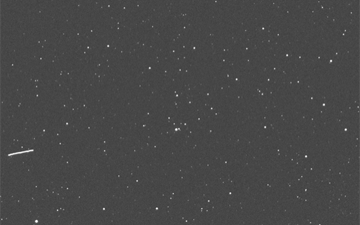
Asteroid 2012 DA14 as Seen from Siding Spring, Australia
This animated set of images, from the telescope known as the iTelescope.net Siding Spring Observatory, shows asteroid 2012 DA14 as the streak moving from left to right in the field of view. The images were taken around 9:40 a.m. PST (12:40 p.m. EST, or 17:40 UTC) on Feb. 15, 2013.
The exposure time was 5 seconds long.
Image courtesy of E. Guido/N. Howes/Remanzacco Observatory
Quelle: NASA
.
Update: 17.02.2013
.
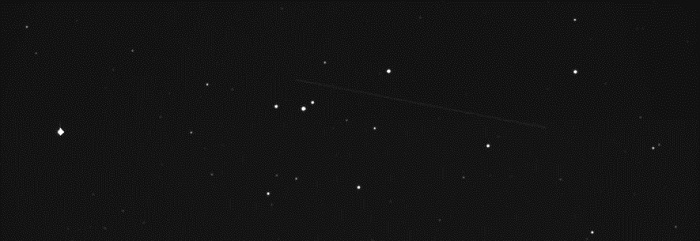
Farewell to a rocky visitor: asteroid 2012DA14 (the near-horizontal streak in the image) seen departing Earth around 23:45 CET after making closest approach at 20:27 CET on 15 February 2013. This image was acquired at ESA's Optical Ground Station (OGS) located on Tenerife, Spain.
